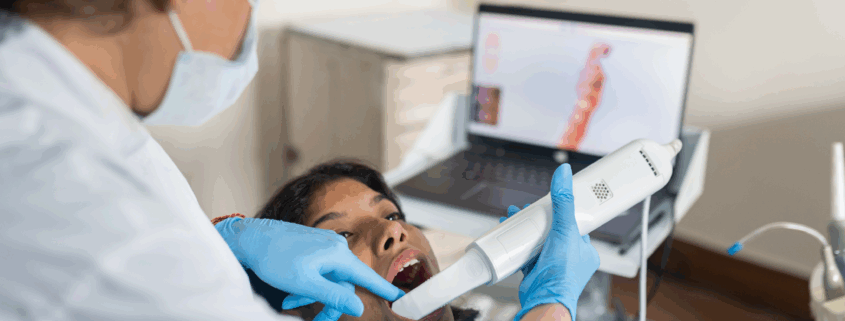Helping Patients Take Control of Their Dental Health with Intraoral Scanners
By Lamia Murray, Service Development Manager at Riverdale Healthcare
For many people, the dentist’s chair can feel like a place where decisions are made for them, not with them. A dentist or dental nurse might explain an issue or suggest a course of treatment, but for the patient this can feel abstract, difficult to picture, and often overwhelming.
Traditional impression-taking – where the patient bites into a tray of putty-like material to create a mould of their teeth – can risk reinforcing this gap. Patients endure a messy, uncomfortable process, and then wait while plaster models are created behind the scenes – with little chance to see or understand the details themselves.
That approach is changing. At more and more Riverdale practices, intraoral scanners are transforming the patient experience. By producing fast, highly accurate digital images of a patient’s teeth and gums, they remove the discomfort of old techniques while opening up new ways to involve patients directly in their own care plans.
This isn’t just about new technology. It speaks to a broader need in UK dentistry: creating greater transparency, improving access, and helping patients feel confident in their choices. At Riverdale, this is central to our vision, embodied in schemes like our Dental Essentials programme – giving more people access to high-quality care and helping them take back control of their dental health.
A clearer picture from the start
The scanners used across many Riverdale practices create precise 3D images in minutes. No messy impressions, no trays. Just a simple digital scan that provides a detailed record of the mouth.
The real difference is that patients can see it too. Instead of results being hidden away in a lab, scans can be shown on screen straight away. This creates a completely new type of conversation between dentist and patient. Both are looking at the same image, discussing it together, and understanding the details in real time.
That is why many Riverdale clinicians now scan new patients at their very first appointment. It sets the tone for a relationship based on openness and clarity from the start.
From simulation to smile
Scanners are more than diagnostic tools – they can also help patients visualise the future.
The software includes features like treatment simulators and “smile designs ” which can show how teeth might look after Invisalign, whitening, or composite bonding. For example, during an Invisalign consultation, a scan can show how teeth could potentially move throughout treatment – making it far easier for patients to see the potential outcome before they commit.
This makes a huge difference. Instead of imagining an outcome from a description, patients can see a projection of their own smile. That builds confidence, reduces uncertainty, and helps people make informed decisions about treatment – including about affordability.
Faster routes to treatment
Digital scans can be sent instantly to dental labs. That means aligners, whitening trays, or even implant guides can often be ready within days rather than weeks. Less waiting, more certainty.
This speed is particularly visible during Riverdale practice open days. Patients can be scanned on the spot, explore treatment options, and discuss pricing with the dental team – often leaving with a clear plan in hand. What might once have required multiple appointments can now happen in a single visit
Education, not just information
Dentistry can sometimes feel full of unfamiliar terms. A scan changes that. When dentists show patients what is happening on screen, the conversation becomes clearer, easier to follow, and easier to remember.
This is especially useful for spotting early warning signs – such as gum recession, enamel wear, or bite issues. Patients can see the issue for themselves and understand why it matters, making them better equipped to take action before problems become serious.
Turning patients into partners
Perhaps the most exciting aspect of intraoral scanners is how they change the patient’s role. Dentistry has often felt like something being done to patients, but with a scan it becomes something they are part of. Many patients, when shown their scan, point out things they would like to change or ask about possible improvements. Treatment planning becomes a genuine partnership, giving people greater confidence in their decisions and commitment to their care.
This reflects exactly what Riverdale aims to achieve: dentistry that is clearer, faster, and more engaging – where patients feel informed, supported, and in control of their health. Intraoral scanners are not just advanced tools, but an important step towards a future of care that is transparent, accessible, and centred on the patient.

